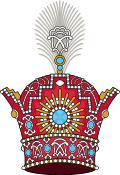| Revision as of 13:27, 19 January 2021 editErminwin (talk | contribs)Extended confirmed users6,523 editsNo edit summary← Previous edit | Revision as of 10:11, 24 May 2021 edit undoBeshogur (talk | contribs)Extended confirmed users33,329 edits added Category:Titles of the Göktürks using HotCatNext edit → | ||
| Line 27: | Line 27: | ||
| ] | ] | ||
| ] | ] | ||
| ] | |||
Revision as of 10:11, 24 May 2021
See also: Tekin and Tigin| Part of a series on |
| Imperial, royal, noble, gentry and chivalric ranks in West, Central, South Asia and North Africa |
|---|
 |

Tegin (Template:Lang-otk, also tigin, MC *dək-gɨn > Pinyin: Tèqín; Chinese: 特勤, erroneously Tèlè 特勒) is a Turkic title, commonly attachable to the names of the junior members of the Khagan's family. However, Ligeti cast doubts on the Turkic provenance by pointing to the non-Turkic plural form tegit
History
History records many people carrying the title Tegin. The best known is Kül Tigin (闕特勤; Queteqin, erroneously 闕特勒; Quētèlè), noted for the stele in his memory in the Orkhon inscriptions. Some Tegins founded and headed their own states. Alp-Tegin, founder of the Ghazni state, which grew into the Ghaznavid Empire; Arslan Tegin and Bughra Tegin, both instrumental in the creation of the Kara-Khanid Kaganate. The Chinese History of the Northern Dynasties states that the Hephthalite emperor of the Gandhara state was from a ruling clan of the neighboring Tegin state. With time, the title tegin became a popular personal name, and now perseveres both as personal and family name, predominantly in the South Asia and Middle East areas.
Notable Tigins
- Alp Tigin
- Anushtakin al-Dizbari
- Anushtegin Gharchai
- Kul Tigin
- Sabuktigin
- Böritigin
- Bilgetegin
- Gazi Gümüshtigin
- Al-Taj Gümüshtegin
- Toghtekin
- Amin Khan Aitigin
References
- Ancient Coin Collecting VI: Non-Classical Cultures, by Wayne G. Sayles p.81
- Sanping Chen, "Son of Heaven and Son of God: Interactions among Ancient Asiatic Cultures regarding Sacral Kingship and Theophoric Names", Journal of the Royal Asiatic Society, Third Series, Vol. 12, No. 3 (Nov., 2002), p. 296: Writing 勒 instead of 勤 is a common script error in current editions of almost all dynastic histories
- Maue, Dieter. "The Khüis Tolgoi inscription - signs and sounds". Academia.edu. Retrieved 4 November 2018. p. 13-14
- Jiu Tangshu vol 194 upper "可汗者,猶古之單于; 其子弟謂之特 (ms. 特勒)" Tr. "the Kehan, in the past, was called Chanyu: His sons and younger brothers are called Te (ms. Tele)"(in Chinese)
- Xin Tangshu Vol. 215 upper (in Chinese) "至吐門,遂強大,更號可汗,猶單於也, 子弟曰特 (ms. 特勒)" tr. "Till Tumen, has achieved strength and greatness and is now called Kehan, formerly Chanyu, sons and younger brothers are called Te (ms. Tele)
- Taskin V.S. "Materials on history of Dunhu group nomadic tribes", Moscow, 1984, p. 432
- Ligeti, L (1975), Kiadó, A (ed.), Researches in Altaic languages, University of Michigan, p. 48
- Sanping Chen, "Son of Heaven and Son of God: Interactions among Ancient Asiatic Cultures regarding Sacral Kingship and Theophoric Names", Journal of the Royal Asiatic Society, Third Series, Vol. 12, No. 3 (Nov., 2002), p. 296, note on misspelling
- Zuev Yu.A. "The strongest tribe Esgil" //Materials of International Round Table, Almaty, 2004, p.44, ISBN 9965-699-14-3